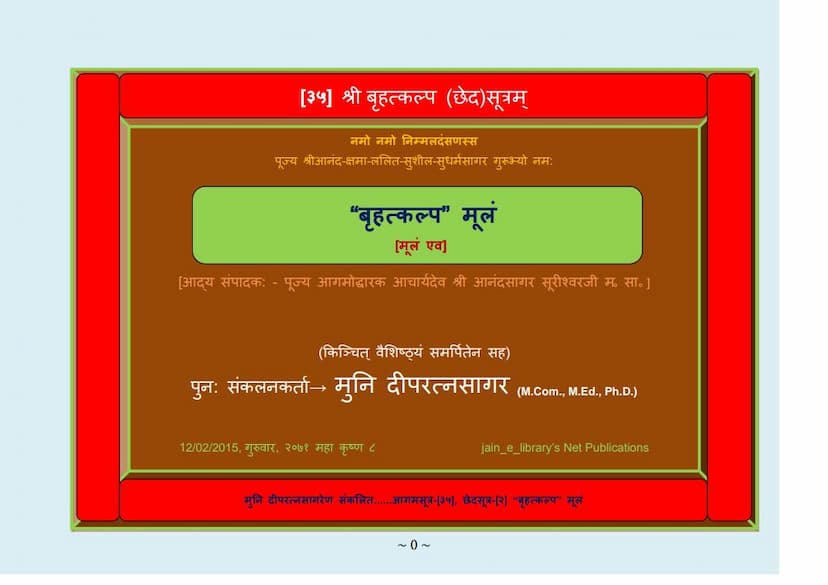Aagam 35 BRUHAT KALP Moolam Ev
Added to library: September 1, 2025

Summary
Here is a comprehensive summary of the provided Jain text, "Brihat Kalpa Moolam Evam," based on the pages you've shared:
Book Title: Brihat Kalpa Moolam Evam (Also referred to as Brihat Kalpa Chhed Sutra) Author(s): Dipratnasagar, Deepratnasagar Publisher: Deepratnasagar Catalog Link: https://jainqq.org/explore/004135/1 Compiler/Editor: Muni Deepratnasagar (M.Com., M.Ed., Ph.D.) Revision/Editing: Acharya Shri Anand Sagar Surishwarji (Sagaranand Suriji)
Overview:
This publication presents the Moolam (original text) of the Brihat Kalpa Chhed Sutra, which is the second Chhed Sutra in the Jain Agamas, representing the 35th Agama. The project is a compilation and presentation of this important Jain scripture, with a focus on accessibility and preserving the legacy of previous scholarly efforts.
Key Features and Content:
- Authenticity and Legacy: The publication emphasizes its origin from the revised and edited work of Acharya Shri Anand Sagar Surishwarji (Sagaranand Suriji), which was originally printed in 1942 (Vikram Samvat 1998). This previous work, titled "Agam Manjusha," was a massive compilation of Jain Agamas. The current publication is a photo-scan of the Chhed Sutras from that earlier edition.
- Preservation and Accessibility: Muni Deepratnasagar has undertaken the effort to make these Chhed Sutras accessible in a digital format, first by converting them to A4 size, then uploading them online, and including them in their DVD publications. The goal is to ensure that this crucial part of the Jain canon is available to a wider audience.
- Structure and Navigation:
- Each page clearly indicates the Agam (35) and Chhed Sutra (2), specifically "Brihat Kalpa" Moolam.
- The text is presented in its original Prakrit language.
- Table of Contents (Vishayanukram): A detailed index is provided, listing each Adhyayan (chapter) or Uddeshak (section) with corresponding page numbers, allowing readers to easily navigate to specific topics.
- Footnotes: Specific pages include footnotes that provide additional information, clarify complex points, or highlight any printing or numbering errors found in the original source.
- "Deep Anukram": A unique sequential numbering system, "Deep Anukram," is used. This system is consistent across all of Muni Deepratnasagar's publications, facilitating cross-referencing and ease of access to their various Agama editions in different languages.
- Verse/Sutra Indicators: The text uses specific markers to distinguish between verses (indicated by "||-||" or the word "Gatha") and sutras (indicated by parentheses "-").
- Content of the Brihat Kalpa Sutra (as sampled in the provided pages):
The sampled pages (Uddeshak 1, 2, 3, 4, 5, and 6) reveal the nature of the Brihat Kalpa Sutra. It details specific rules and guidelines (Kalpa) for Jain monks (Nigranthas) and nuns (Nigranthis). These rules cover a wide range of conduct and prohibitions, including:
- Permitted and prohibited actions: The text meticulously outlines what is allowed and what is forbidden for ascetics in various situations. Examples include:
- Permitted ways of receiving or accepting food and alms.
- Rules regarding clothing, utensils, and personal belongings.
- Restrictions on travel, dwelling places, and interactions with the outside world.
- Prohibitions related to harming living beings, even indirectly.
- Guidelines for observing vows and periods of austerity.
- Rules concerning interactions within the monastic community and with lay followers.
- Specific Scenarios: The sutras address a multitude of specific scenarios that monks and nuns might encounter, providing clear directives for each. This suggests a highly detailed code of conduct.
- Penance and Atonement: The text also mentions the consequences of violating these rules and the types of penances (e.g., Chaturmasika Pariharahaanam) that may be required.
- Permitted and prohibited actions: The text meticulously outlines what is allowed and what is forbidden for ascetics in various situations. Examples include:
- Physical Manifestation: The publication notes that the original text was inscribed on stone plates at Shatrunjay Tirth and on copper plates in Suratnagar, highlighting the historical significance and reverence for this scripture.
- Purpose of the Publication: Muni Deepratnasagar expresses his motivation as a service to the Agamas and to honor the deep respect people hold for Acharya Sagaranand Surishwarji. By re-publishing these Chhed Sutras, he aims to prevent the misconception that only the 45 Agamas are part of the canon, ensuring the inclusion of the six Chhed Sutras as well.
- Future Plans: The current publication is an "Internet Publication" for wider reach, with plans for future printing.
In essence, "Brihat Kalpa Moolam Evam" is a meticulous presentation of a foundational Jain scripture that codifies the ascetic life. It is made accessible through modern digital means, building upon the scholarly work of revered Acharyas, and aims to provide a clear, well-indexed, and authentic resource for the study and practice of Jainism.